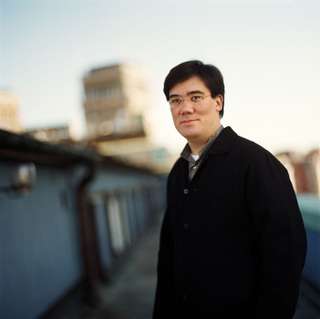|
Back
Dancing in the Snow New York
Avery Fisher Hall, Lincoln Center
12/28/2010 - & December 29, 30, 2010
Peter Ilyich Tchaikovsky: Polonaise from “Eugene Onegin” – Selections from “Nutcracker” Suite: Overture, March, Divertissments, Waltz of the Flowers
Jean Sibelius: Valse triste
Antonio Vivaldi: Concerto in B minor for Four Violins, Opus 3, Number 10 (RV 580)
Claude Achille Debussy: Prelude to the Afternoon of a Faun
Maurice Ravel: Boléro
Sheryl Staples, Michelle Kim, Marc Ginsberg, Lisa Kim (Violins), Carter Brey (Cello), Paolo Bordignon (Harpsichord)
New York Philharmonic Orchestra, Alan Gilbert (Conductor)

A. Gilbert (© Mats Lundquist)
Driving from Massachusetts to New York through a blizzard on Sunday would be worth it, for the Phil was not only presenting its soloists in very rare concertos, but was giving the world premiere of a work by Aaron Jay Kernis. But the holiday Act of (a malicious) God precluded enough rehearsal time, so an alternative program was devised.
Thus it was without enthusiasm that I came to hear a program of very familiar works. Add to this the difficulty of subway traffic, and the slushy lanes on 65th St. and Broadway to make me imagine a concert by the New Yuck Philharmonic.
But subscription audience was expecting an unchallenging evening, Alan Gilbert was in his usual happy mood, and I could almost forgive the well-fed patrons who were wearing coats composed of electrocuted woodland animals.
Mr. Gilbert’s joy could have been twofold. First, the NY Phil, having played these works many times before, would give them an extra oomph to they wouldn’t sound tired. And Mr. Gilbert had selected pieces which called for dancing, so nobody could berate him a little exaggeration on the podium.
The first half was Russian dance in style, starting with that great waltz-maker Tchaikovsky. The “Grand Polonaise” was surprisingly spectacular, with Mr. Gilbert allowing his orchestra to hang out with accentuated rhythms, a pace which would have picked up any dour performance of Eugene Onegin.
Despite the salon title, Sibelius’ Valse Triste played by the full orchestra, not the usual string quartet arrangement, had an equally full-blooded rendition. Forget that it ends with Death on the doorstep, Mr. Gilbert allowed it first to sing, and then, picking up speed, it became particularly Russian-sounding, the dark swampy Finnish landscape transported to the Russian steppes.
I thought I could escape Christmas without a Nutcracker, but these excerpts gave an opportunity to study some Tchaikovsky idiosyncrasies: the slow twirls of the “Arabian dance”, a sudden English horn out of nowhere, and in the “Dance of the Reed Flutes”, the brass playing a two-note motif endlessly, offering its own exotica. A lovely performance.
The second half of the concert was–to my mind–all French. Yes, Debussy’s Prelude to the Afternoon of a Faun with a superb flute solo by First Chair Robert Langevin. And yes, Ravel’s Boléro, the ultimate dance of this dance concert, giving everybody in the orchestra at least a few measures in which to shine.
But was Antonio Vivaldi a Frenchman?? Of course not. But the Four-Violin Concerto will always be recognized for its part in a French classic.
The first time I heard the second movement was in Jean-Pierre Melville’s 1950 movie, Les Enfants terribles. The black-and-white film itself is a chilling picture of incest and jealousy, hurt and love, games and blood. Most of the music is from a Bach harpsichord concerto. But the most frightening part is silent except for the slow movement from Vivaldi’s original Concerto For Four Violins.
The Largo–the first section of the movement–is played over a pantomime of the brother and sister. But when the music increases in tempo to a larghetto, when the music is pure texture without any melody at all, then we hear the voice of the writer, Jean Cocteau.The words are poetic, but intense, with the most extreme emotions held back as if on a taut rope. above the music.
The shock of that moment is one of the great moments of film. And those rare times when I have heard the piece played live, my mind is clouded by these splendid harrowing scenes. Ever since, when musical poetasters state that Vivaldi wrote the same piece a thousand times, I must remember the effects his music can have in the right circumstances.
This performance was scintillating, as the whole concert was scintillating. The orchestra was abbreviated to a Vivaldi-size chamber ensemble. Had the four violinists played exactly in time, the natural flow would have seemed constricted. The music wasn’t blurred, but each player had different points to make at different times, so one felt they were playing for the fun of it.
The slow movement still brought back “the snows of yesteryear”, but both the orchestra and soloists knew they were taking part in a concert to melt the snow of our present day.
In other words, it’s the thawed that counts!
Harry Rolnick
|